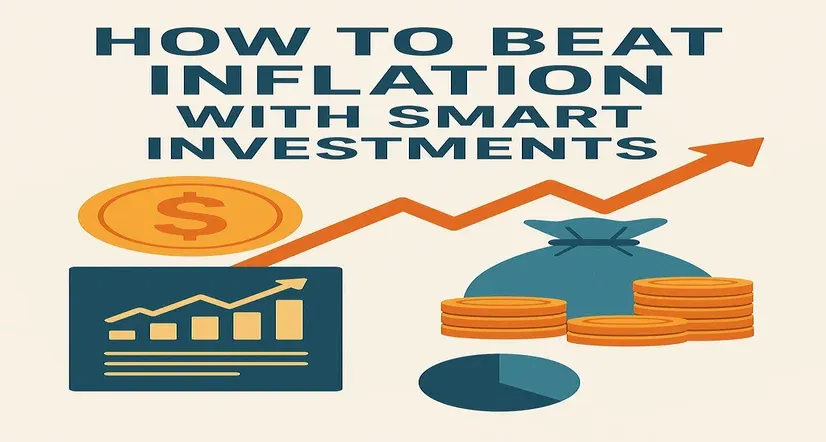How to Beat Inflation with Smart Investments


Anita stares at her bank statement, frustrated. After five years of diligently saving ₹15,000 every month, she has accumulated ₹9 lakhs in her savings account.
She's always been the ‘responsible one’. Tracking every expense, never missing a savings goal. “I am being responsible with money,” she tells herself as she slogs to set cash aside month after month! But the numbers don't add up when she calculates what she needs for a house down payment next year. Despite her discipline, her money barely seems to have grown.
Sound familiar? If you’re a working professional, there’s a high-chance you're making the same critical mistake. And this ‘Savings Illusion’ is quietly eroding your wealth every day.
Here's the uncomfortable truth: "Keeping your money in a savings account isn't just unproductive, it's actively destroying your purchasing power."
Most banks in India offer savings account interest rates between 2.50% to 3.00% per annum, with some private banks offering up to 7.00% for higher balance accounts.
Meanwhile, inflation in India was 1.55% in July 2025, down from higher levels in previous years. Despite current low inflation rates, the historical average hovers around 4-6% annually.
Let's examine what happened to Anita's money over five years of "disciplined saving". She deposited ₹15,000 monthly from 2020 to 2025, totalling ₹9 lakhs in principal. Her savings account, earning 3% annually with quarterly compounding, added approximately ₹73,000 in interest over this period, bringing her total corpus to ₹9.73 lakhs. It looks like responsible financial behaviour; she even 'earned' some money on paper.
But here's the uncomfortable reality: average inflation ran at approximately 5.8% annually during this same period. It means that what ₹9.73 lakhs could purchase in 2020 now requires nearly ₹13 lakhs. In real terms, Anita's accumulated wealth has the purchasing power of just ₹7.3 lakhs in 2025.
Ouch.
(Skip the next section, if you're averse to Math. The rest of this piece will still make sense. Promise!)
Real Return = [(1 + Nominal Return) / (1 + Inflation Rate)] - 1
Anita's Case:
Real Return = [(1 + 0.03) / (1 + 0.058)] - 1 = -2.65% annually
Real Future Value = FV / (1 + inflation)^n
₹9.73L in 2025 = ₹9.73L / (1.058)^5 = ₹7.3L in 2020 purchasing power
Despite earning interest and never spending frivolously, Anita has lost ₹1.7 lakhs worth of purchasing power. That's an 18% erosion of her real wealth. The cruel irony? While she thought she was financially responsible and even 'making money' through interest, inflation stole from her savings account faster than the bank was paying her.
The idea isn't to abandon safety entirely; it's to understand that different types of money serve various purposes. If Anita had understood this goal-based strategy five years ago, her story would be completely different today.
Here's the proven framework most successful investors use:
Safety Net: Emergency Fund (3-6 months expenses) Keep this in high-yield savings accounts or liquid funds. This isn't for growing wealth; it's insurance against life's uncertainties. For someone with monthly expenses of ₹40,000-50,000, this means ₹1.2-3 lakhs in readily accessible funds.
Short-term Goals (1-3 years) Money needed for house down payment, car purchase, or wedding should go into debt mutual funds or fixed deposits. Target: 6-8% annual returns with capital protection.
Long-term Wealth Creation (5+ years) This is where real wealth building happens. Historical data shows that equity investments have delivered 12-15% CAGR over 15-20 year periods, despite short-term volatility.
Want to put all this into practice? Try this practical allocation:
Action Steps:
Smart Tools to Use:
Mistake 1: Waiting for the ‘right time’ to start investing
Fix: Start with small amounts immediately; time in-market beats timing the market
Mistake 2: Putting all money in one asset class
Fix: Diversify across equity, debt, and maintain emergency liquidity
Mistake 3: Getting paralysed by too many options
Fix: Start with 1-2 broad market index funds, expand knowledge gradually
Remember: the best investment strategy is the one you actually implement. Even an imperfect start beats perfect planning without action.
Now consider Anita's alternate reality. What if she had invested that same ₹15,000 monthly in equity funds earning 12% instead of her savings account, she would have accumulated nearly ₹25 lakhs by now instead of ₹9.73 lakhs.
Looking ahead, the true cost of playing it ‘safe’ becomes even starker:
₹15,000 monthly investment over 20 years:
That's a difference of nearly ₹1 crore, the cost of playing it ‘safe’.
Anita's realisation came five years too late, but yours doesn't have to. The journey from savings account dependency to wealth creation starts with understanding this fundamental truth: your money should work harder than you do. Make that shift today.
Disclaimer: This article is for educational purposes only. Please consult with a financial advisor for personalised advice.